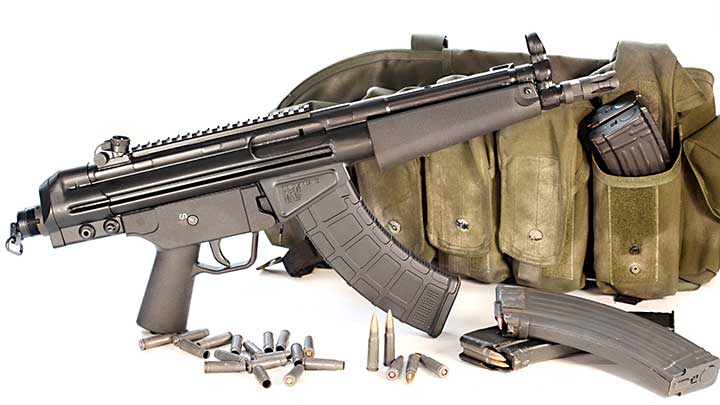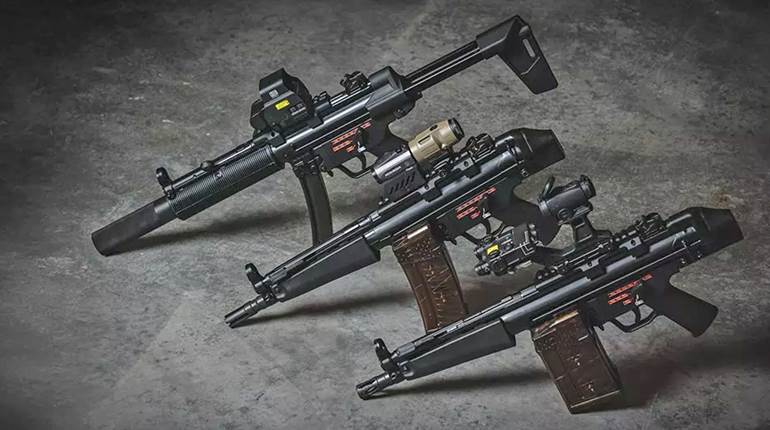

South Carolina-based PTR Industries offers roller-delayed rifles and pistols in 7.62x39 mm. While this may seem like an odd pairing, the history of the 7.62x39 mm cartridge and Western firearm designs goes deeper than one might guess. In the early days of the Cold War, several European small arms manufacturers thought they could make forays into markets were the SKS and AK-47 were already in use, by adapting their existing designs to the 7.62x39 mm cartridge.

Two examples of this were the SIG 510-3 and Madsen LAR. Another company to attempt this was Rheinmetall, who, along with Heckler & Koch, had been contracted to manufacture Germany's G3 service rifle. Rheinmetall designed the 7.62x39 mm RH4. Though the rifle's external lines mimicked the CETME and G3, it was gas-operated and used a roller locked breech mechanism. It was designed to utilize the AK-47 magazine. Production never advanced beyond the prototype stage.

Heckler & Koch would also make a 7.62x39 mm version of the G3 in the 1960s. The HK32 stuck with the roller-delayed blowback design of the G3 and paired it with a proprietary box magazine. The company also offered 7.62x39 mm versions of its HK21 light machine gun, as well as the HK12 light machine gun. Though small numbers of the HK32 were manufactured, the model was never adopted or sold in large quantities and production was dropped by the late 1970s. Those in the Eastern Bloc and other parts of the world were happy with their AKs, thank you very much.

In the Western world, the 7.62x39 mm would remain an obscure cartridge for decades after its introduction. Some of the earliest AK-type rifles imported to the U.S., made by Valmet of Finland, sold more in .223 Rem. chambering than its original 7.62x39 mm chambering. In the late 1980s and early 1990s, an influx of affordable SKS and AK firearms, along with cheap 7.62x39 mm ammunition from China, led to the caliber gaining popularity in this country. A wide variety of firearms, including the .223 Rem. AR-15 and Mini-14, were adapted to the Soviet cartridge. Not only was import ammo affordable, the .30 caliber round was legal for deer hunting in many states.

PTR Industries has a long experience in building roller-delayed firearms, starting 18 years ago when they purchased the G3 production line from the Portuguese government. In 2010 they introduced a 7.62x39 mm model to their roller-delayed line-up. Designated the PTR-32, the design combines elements of both the RH4 and the HK32. Like the RH4, it utilizes a standard 7.62x39mm AK magazine. As G3 rifles don't have a bolt hold open device and use a "paddle" magazine release, this adapts perfectly.
Like the HK32, the PTR-32 uses a roller-delayed blowback system. PTR's 32 series is available as a 16" barreled rifle or 12.5" or 8.5" barreled pistols. The latter is the subject of our review.

To build the 32-series, PTR starts out with the basic architecture of their 91-series 7.62 mm NATO firearms. The receiver is stamped steel with a welded-in front trunnion and uses a "shelf"-type front attachment point for the trigger housing. Due to the design of AK magazines, the button release that other PTR firearms use is eliminated and only the "paddle" magazine release, familiar to users of both AK and HK-type firearms, is retained. The trigger housing is a polymer "single fire" unit with "S" and "F" markings and a left-side only safety selector switch. Barrels have their muzzles threaded 5/8X24” with an HK-type muzzle brake attached.

Unlike the original HK receiver design, which requires special optics mounts, PTR offers a built-in accessory rail on the receiver of all of their roller-delayed firearms. In the case of the PTR-32 it is 6.88" long. The only downside to the rail is that an "overhand" grip on the charging handle can cause the rail to have a cheese grater effect on the first joint of the thumb. The supplied iron sights are the classic hooded post front and a "diopter" rear aperture that is adjustable for windage and elevation.

The smallest of PTR's 7.62x39 mm line-up, the PTR-32P PDWR uses an 8.50" barrel that is slightly longer than the 5.56x45 mm NATO mm HK53 compact rifle. Think of it as an MP5 in 7.62x39 mm. The PDW's barrel length matches that of the MP5 and, like the HK53, the PTR-32 can utilize handguards and rails designed for the MP5. It comes supplied with a "tropical" wide polymer handguard. The PDW is compatible with Magpul's recently released grip module, extended selector lever and handguard (see our review of these components, along with a video of how to install them here). The built-in handstop on the latter is particularly useful when firing the pistol off-hand.

Because of the G3-sized receiver, MP5-style stocks and arm braces will not work. The 32-series is compatible with all G3-type stocks and braces, however the PDW versions of PTR's 7.62x51 mm NATO and 7.62x39 mm PDW pistols use a special telescoping extension on their recoil spring guide rod. Fortunately, companies like HK Parts offer A3-style telescoping stocks (for those wishing to legally transform their pistol into a short barreled rifle) specifically modified for the PTR PDWs.
PTR makes it easy for those who want to use the pistol with an arm brace. PTR pistols are supplied with a receiver end cap that has a sling swivel mounted for use with a single-point sling. The sling mount extension can be removed and an M4-type receiver extension installed, which allows for the use of AR-15 pistol braces.

PTR states that their 32-series firearms are compatible with Magpul PMAG-spec AK magazines. From our collection of metal military surplus AK mags, only a few would lock in reliably in the PTR. Those that did, functioned perfectly. The magazine well does not accommodate military-style metal drum magazines.
We experienced no malfunctions during testing with steel or brass-cased ammunition. The pistol also reliably fed a variety of bullet types, from FMJ to hollow point to soft-point round-nose. As with all roller-delayed firearms, ejection is forceful, though the PTR-32 does not damage its brass, as some roller-delayed firearms are known to do. The streaks left by its fluted chamber are superficial only and spent brass cases are left in reloadable condition.

At 8 lbs. 6 ozs. the PTR-32P PDW weighs about three pounds more than HK's recently released 9 mm SP-5 pistol. The weight, combined with the smoothness of its roller-delayed blowback action, makes for one soft shooting rifle-caliber pistol. The trigger pull is easier to manage than its 8 lb. weight would imply. The two-stage unit breaks crisply. These two factors combined to yield five-shot groups at 25 yds. with an overall average from three different types of ammunition being just under an inch.
The 7.62x39 mm has nearly identical ballistics to the .300 Blackout, which makes it ideal for short barrel applications. The 8.5" barrel of the PTR-32 PDW launches 123-gr. projectiles right at 2,000 f.p.s., delivering about 50% more energy than would be expected from a 5.56x45 mm NATO bullet out of this barrel length.

PTR's 32 series is ideal for those interested in a roller-delayed firearm that fires a cartridge that splits the difference between the 9 mm and the 7.62x51 mm NATO. Even in these days of exorbitant prices and scarcity, 7.62x39 mm ammunition is some of the most "affordable" and "available" centerfire rifle rounds out there. Combine that with the most popular magazine format in the world and you have a firearm where practical meets performance, with a historic East meets West twist.
Note: PTR is currently building only 9 mm and 7.62x51 mm NATO firearms to meet the present demands. Though they plan to produce the PTR-32 again in the future, at this time they have not announced when the series will again be available.

PTR-32P PDW Specifications
MANUFACTURER: PTR Industries, Inc. 101 Cool Springs Drive, Aynor, SC 29511, (843) 358-2222; ptr-us.com
MODEL: 32P PDWR PTR 203
ACTION: Roller-Delayed Blowback, Semi-Automatic, Centerfire Pistol
CALIBER: 7.62X39 mm
RECEIVER: 1018 Sheet Steel
BARREL: 4140 Chrome Alloy Steel, Fluted Chamber, Muzzle Threaded 5/8X24"
TWIST: Six-Groove, 1:10” RH Twist
TRIGGER PULL: 8-lbs., 1-oz.
SAFETY: LeftSide Only
FRONT SIGHT: Fixed Post
REAR SIGHT: Drum With Aperture, Adjustable For Windage And Elevation
BARREL LENGTH: 8.38"
OVERALL LENGTH: 23.88”
HEIGHT: 8.2” Without Magazine
WIDTH: 2.5"
WEIGHT, UNLOADED: 8-lbs., 6.2-ozs. With 30-round Magazine
MAGAZINE: Detachable Box, Compatible With 7.62X39 mm AK-Type Magazines
ACCESSORIES: Hard Case, Gun Lock, Owner's Manuel
MSRP: $1,418



































